Lavender’s enchanting fragrance and stunning purple blooms have captivated gardeners for centuries, but did you know there are actually dozens of different lavender varieties to choose from? We’ve discovered that understanding the unique characteristics of each type can transform your garden from ordinary to extraordinary.
Whether you’re planning a fragrant herb garden or looking to create a drought-resistant industry, selecting the right lavender variety makes all the difference. From the compact English lavender perfect for borders to the dramatic French lavender with its distinctive butterfly-topped flowers, each type offers something special for your outdoor space.
We’ll guide you through the most popular lavender varieties and help you discover which ones thrive in your climate zone. You’ll learn about their bloom times, growth habits, and unique features that make certain types perfect for cooking, crafting, or simply enjoying their therapeutic aromatherapy benefits.
English Lavender (Lavandula angustifolia)
English lavender stands as the most versatile and widely cultivated lavender species, earning its reputation as the gold standard for gardeners worldwide. We consider this variety the perfect starting point for anyone wanting to grow lavender successfully.
Common Varieties and Cultivars
Hidcote produces deep purple flower spikes and maintains a compact 12-18 inch height, making it ideal for borders and containers. This cultivar blooms from early to mid-summer and offers exceptional drought tolerance once established.
Munstead reaches 15-18 inches tall with lighter purple blooms that appear earlier than most varieties. We recommend this cultivar for cooler climates since it handles lower temperatures better than other English lavender types.
Royal Velvet showcases rich purple flowers on sturdy stems that grow 18-24 munstead tall. This variety extends the blooming season from June through August and produces excellent cut flowers for arrangements.
Folgate develops into a neat 18-inch mound with pale purple spikes that bloom repeatedly throughout summer. Gardeners appreciate this cultivar’s ability to maintain its shape without frequent pruning.
Growing Conditions and Care Requirements
Full sun exposure provides the foundation for healthy English lavender growth, requiring at least 6-8 hours of direct sunlight daily. We’ve observed that insufficient light leads to leggy growth and reduced flowering.
Well-draining soil prevents root rot and other moisture-related problems that commonly affect lavender plants. Sandy or gravelly soils work best, though you can improve heavy clay by adding coarse sand and organic matter.
pH levels between 6.5-7.5 create optimal growing conditions for English lavender varieties. Alkaline soils actually benefit these plants more than acidic conditions, contrary to many other garden perennials.
Minimal watering suits established English lavender best, as overwatering causes more problems than drought stress. Water deeply but infrequently during the first growing season, then reduce irrigation once plants establish strong root systems.
Annual pruning maintains plant shape and encourages vigorous growth each season. Cut back one-third of the plant height after flowering ends, typically in late summer or early fall.
Best Uses for English Lavender
Culinary applications make English lavender the preferred choice for cooking and baking projects. We use the flowers and leaves to flavor honey, teas, baked goods, and herb blends because of their sweet, floral taste.
Essential oil production relies heavily on English lavender due to its high-quality oil content and therapeutic properties. This variety produces oils with the most balanced linalool and linalyl acetate levels for aromatherapy uses.
Border plantings benefit from English lavender’s uniform growth habit and reliable blooming schedule. Space plants 18-24 inches apart to create stunning hedge effects or pathway borders that release fragrance when brushed against.
Dried flower crafts use English lavender’s long-lasting scent and attractive appearance in sachets, potpourri, and wreaths. Harvest flower spikes just before full bloom opens for the strongest fragrance retention in dried arrangements.
French Lavender (Lavandula dentata)
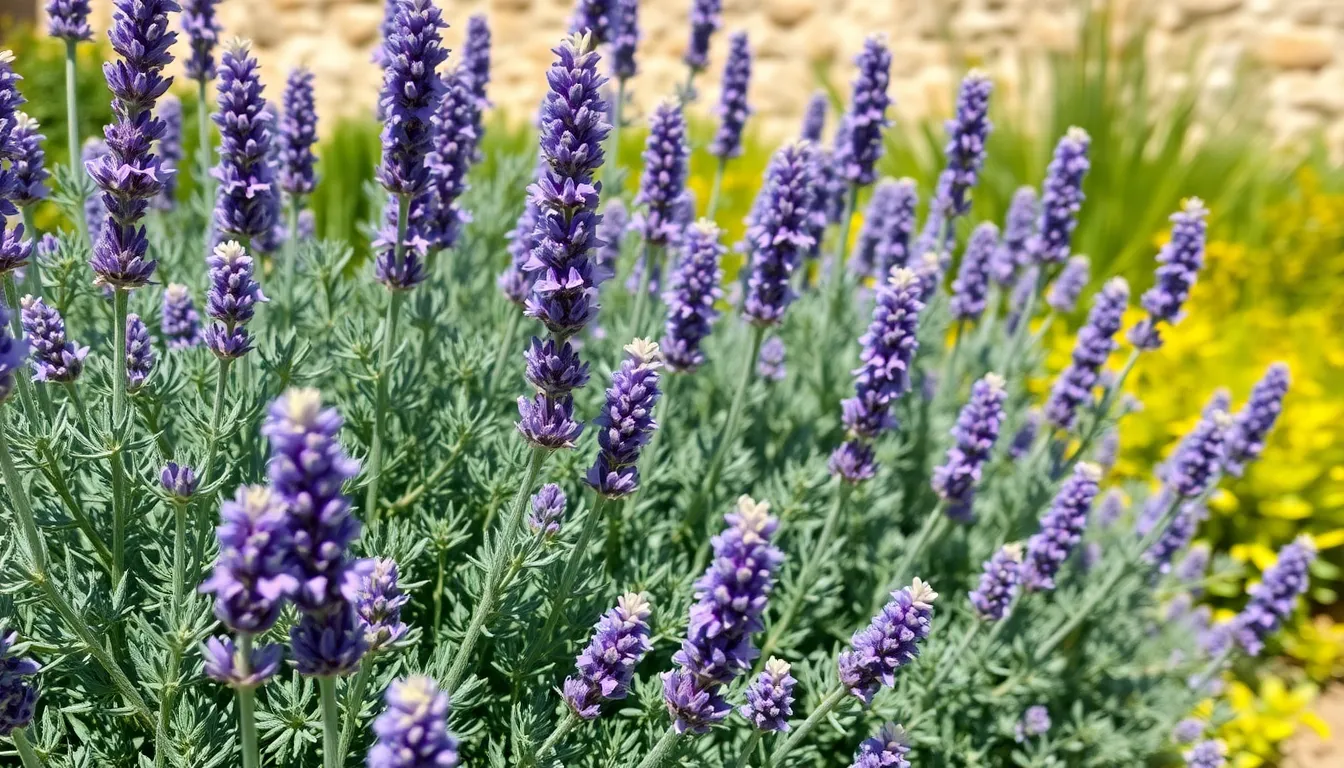
French lavender stands out among lavender varieties with its unique toothed foliage and year-round blooming potential. We’ll explore what makes this Mediterranean native a distinctive choice for warm climate gardens.
Distinctive Characteristics and Appearance
French lavender grows as an evergreen subshrub reaching 2 to 5 feet in both height and width. The gray-green leaves feature distinctive scalloped or toothed edges that give this variety its common name “toothed lavender.” These linear to lance-shaped leaves create a uniquely textured foliage that sets it apart from other lavender species.
Flowering occurs on long stalks that produce narrow spikes of light purple or violet blooms. The flowers are topped with pale violet bracts that have serrated edges, creating a “fringed” appearance. While the plant maintains the classic lavender fragrance, its scent is generally lighter than that of English lavender varieties.
Climate Preferences and Hardiness
French lavender thrives in Mediterranean climates with dry, sunny conditions and well-drained alkaline soils. This variety prefers full sun exposure and demonstrates exceptional drought tolerance, making it perfect for xeriscaping and low-water garden designs.
The plant is perennial in USDA Zones 8 to 11, though it may need protection in frost-prone areas due to its lower cold tolerance compared to other lavender species. In frost-free, warm climates, French lavender can bloom throughout the entire year. Cooler regions will see blooming from early spring through fall.
Popular Cultivars to Consider
Lavandula dentata var. dentata ‘Royal Crown’ stands as the most notable cultivar, having received the Royal Horticultural Society’s Award of Garden Merit. This cultivar is recognized for its robust growth habit and particularly attractive flowering spikes.
Other cultivars of French lavender offer variations in leaf size, flower dimensions, and color intensity. All cultivars maintain the characteristic toothed foliage and fragrant blooms that define the species. These varieties provide gardeners with options while preserving the distinctive Mediterranean appeal that makes French lavender valuable for ornamental use and essential oil production.
Spanish Lavender (Lavandula stoechas)

Spanish Lavender stands out as one of the most ornamental lavender species, offering gardeners a distinctive alternative to traditional varieties. We’ll explore its remarkable characteristics that make it a showstopper in Mediterranean gardens.
Unique Flower Structure and Colors
Spanish Lavender captivates with its barrel-shaped flower spikes topped by colorful, petal-like bracts that create a striking visual display. These distinctive bracts resemble butterfly wings or rabbit ears, earning this species popular nicknames like “butterfly lavender” and “rabbit’s ears.” The flowers typically showcase deep purple hues, while cultivars like ‘Purple Ribbon’ display particularly rich and vibrant colors that enhance any garden setting.
Rising above silvery-green, narrow foliage, the flower spikes create an elegant contrast against the plant’s aromatic leaves. We find that the leaves emit a strong piney fragrance when crushed, adding another sensory dimension to this already impressive species. This unique flower structure sets Spanish Lavender apart from other lavender varieties, making it an excellent choice for gardeners seeking something truly distinctive.
Seasonal Blooming Patterns
Blooming extends from late spring through summer, providing gardeners with an exceptionally long flowering season that maximizes garden impact. The flower spikes appear on mostly leafless stems during the blooming cycle, creating a clean, architectural appearance that many gardeners find appealing. We appreciate how this extended bloom period ensures continuous color and fragrance throughout the warmer months.
Maintenance and Pruning Needs
Spanish Lavender thrives as a woody perennial sub-shrub that performs best in full sun and well-drained soil conditions. Growing compactly between 10 to 24 inches tall and 1 to 3 feet wide, this species fits perfectly in borders, containers, and hedge applications. The plant demonstrates excellent heat and drought tolerance while remaining deer and rabbit resistant.
| Growth Characteristics | Specifications |
|---|---|
| Height Range | 10-24 inches |
| Width Range | 1-3 feet |
| USDA Zones | 7-10 (occasionally to 6) |
| Sun Requirements | Full sun |
| Soil Preference | Well-drained |
Pruning requires careful attention after flowering to maintain shape and promote bushier growth, though we must handle this species more gently than common lavender varieties due to its more fragile nature. The evergreen foliage persists through warmer winters, providing year-round aromatic presence in suitable growing zones. Regular maintenance ensures optimal performance while preserving the plant’s natural compact form and continuous flowering potential.
Lavandin (Lavandula x intermedia)

Moving beyond traditional lavender species, we encounter lavandin, a remarkable hybrid that combines the best traits of its parent plants. This versatile lavender offers unique advantages for both commercial growers and home gardeners.
Hybrid Origins and Characteristics
Lavandin emerges from crossing English Lavender (Lavandula angustifolia) with Portuguese or Spike Lavender (Lavandula latifolia), creating a plant that inherits superior qualities from both parents. We notice this hybrid produces larger shrubs with more abundant flower spikes compared to its parent species.
Blooming patterns set lavandin apart from other lavender varieties, with flowers appearing later in the season from July to September. Seeds develop from August to October, extending the plant’s productive period well into fall months.
Growing requirements mirror those of other Mediterranean lavenders, demanding full sun exposure and well-drained soil conditions. Cold hardiness proves somewhat less robust than English lavender, making lavandin better suited for milder climate zones.
Culinary applications remain limited due to the plant’s intensely strong flavor, though we can use the aromatic leaves and flowers as condiments or tea flavorings in small quantities.
Commercial Uses and Essential Oil Production
Essential oil extraction drives most commercial lavandin cultivation, with growers harvesting the blooms specifically for perfumery and aromatherapy applications. We find these oils possess a distinctly floral and potent fragrance that differs from traditional English lavender oils.
Food flavoring industries use lavandin essential oils in various products, capitalizing on the hybrid’s robust aromatic compounds. Production yields often exceed those of pure lavender species, making lavandin economically attractive for large scale operations.
Fresh flower harvesting supports the cut flower industry, with stems maintaining their fragrance and appearance longer than many other lavender types. Dried flower applications include sachets, lavender wands, and decorative arrangements that benefit from lavandin’s lasting scent.
Top Lavandin Varieties for Gardens
Phenomenal Lavender stands out as our top recommendation for garden cultivation, reaching 3 to 4 feet in both height and width. Gray-green foliage provides an attractive backdrop for tall stems crowned with fragrant purple flowers that bloom continuously from June through October.
Lavandula x intermedia ‘Alba’ offers gardeners seeking white flowered varieties an excellent choice with elongated flower spikes and light, flowery fragrance. Essential oil quality from this cultivar ranks among the highest, though production quantities may be smaller than purple flowering varieties.
Lavandula x intermedia ‘Grosso’ delivers exceptional fragrance intensity and abundant oil production, making it a favorite among commercial growers and home gardeners alike. Strong scent characteristics make this variety particularly valuable for aromatherapy applications.
Lavandula x intermedia ‘Provence’ and ‘Riverina Thomas’ round out our recommended cultivars, each providing reliable ornamental appeal combined with excellent essential oil yields for various garden and commercial applications.
Woolly Lavender (Lavandula lanata)
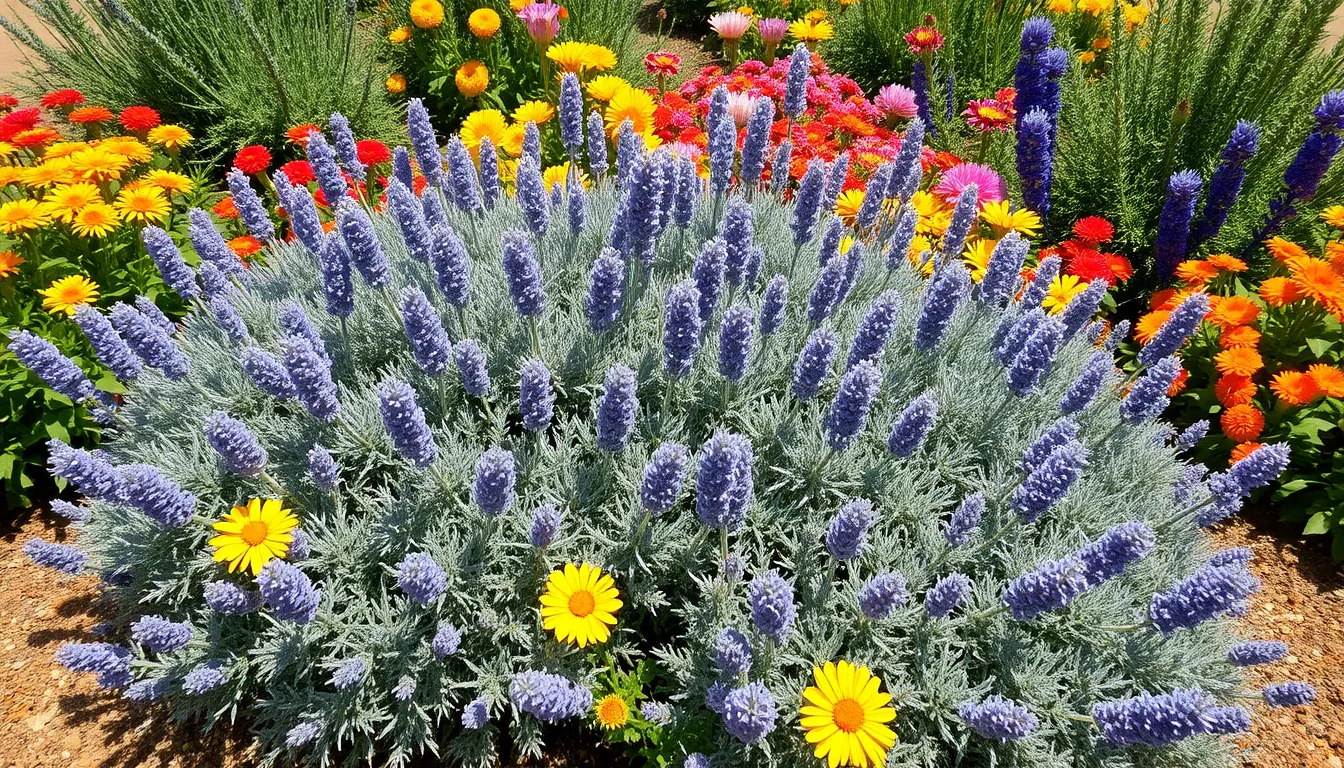
Woolly Lavender stands out among lavender varieties with its distinctive silver gray foliage and remarkable Mediterranean heritage. This species offers gardeners a unique combination of visual appeal and practical drought resistance that makes it increasingly popular in modern industry design.
Silver Foliage and Texture Features
Dense woolly leaves create the most striking feature of Lavandula lanata, giving this species its common name. Silver gray coloration covers the entire foliage, providing a soft silvery texture that contrasts beautifully with traditional green garden plants. Reflective properties of these unique leaves help protect the plant from intense heat by bouncing sunlight away from the surface. Visual interest increases dramatically when we incorporate this textured foliage into garden designs, as the woolly appearance adds depth and dimension to plantings.
Drought Tolerance and Mediterranean Origins
Native Mediterranean regions shaped Woolly Lavender’s exceptional ability to thrive in hot, dry climates with minimal water requirements. Extended dry periods pose no challenge to this hardy species, making it perfect for xeriscaping and water wise gardening approaches. Full sun exposure suits this lavender best, along with well drained soil that mimics its natural Mediterranean habitat. Neutral to alkaline soil conditions provide the ideal growing environment, reflecting the limestone rich soils of its native range. Climate adaptation allows Woolly Lavender to flourish where other plants struggle with heat and drought stress.
Industry Design Applications
Groundcover applications showcase Woolly Lavender’s versatility, as its low growing habit and spreading nature create attractive living carpets. Border edging becomes more ever-changing when we use this species to define garden spaces with its distinctive silver foliage. Rock gardens benefit tremendously from Woolly Lavender’s texture, which softens hard stone surfaces while requiring minimal maintenance. Pollinator attraction adds ecological value to gardens, as bees and butterflies visit the flowers regularly throughout the blooming season. Garden biodiversity increases when we incorporate this species alongside colorful flowering plants, creating stunning textural contrasts that enhance overall industry appeal.
Fernleaf Lavender (Lavandula multifida)
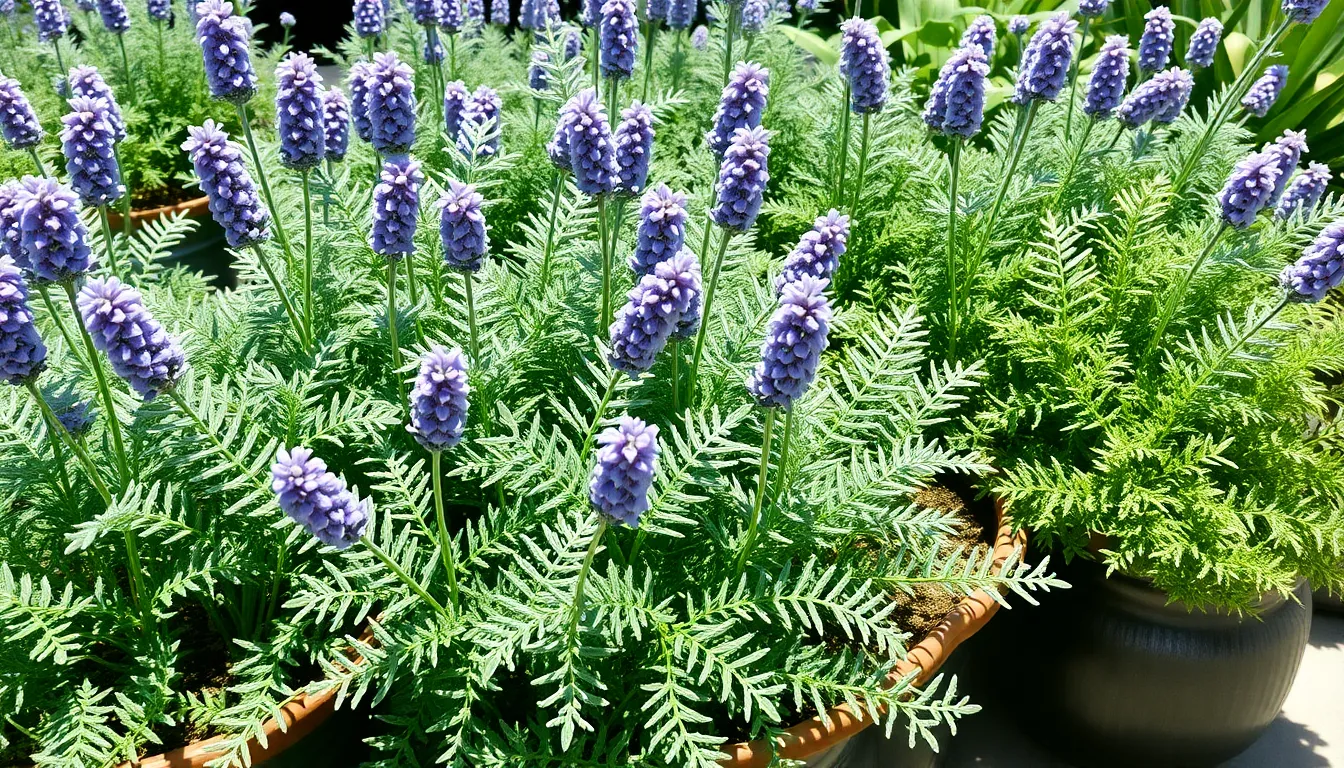
We encounter one of the most distinctive lavender varieties in Fernleaf Lavender, which stands apart with its unique fern-like appearance and Mediterranean origins. This aromatic plant offers gardeners something completely different from traditional lavender varieties we’ve explored.
Delicate Foliage and Compact Growth
Fernleaf Lavender displays exceptionally fine, lacy foliage that resembles delicate fern fronds rather than typical lavender leaves. The plant develops double pinnate, silver-green leaves on straight, grey, woolly stems that create a soft, textural appearance in garden settings. Growing to a manageable 24 inches (61 cm) tall, this variety maintains a compact, mounding growth habit that works perfectly for smaller spaces and container gardens.
Violet-blue or dark blue flowers crown the long stems in single or three-pronged formations, creating striking visual contrast against the silvery foliage. The blooms attract bees and butterflies while providing nearly year-round color in mild climates. Interestingly, the foliage emits an oregano-like aroma instead of the classic lavender scent, adding a unique sensory dimension to garden experiences.
Indoor Growing Possibilities
We can successfully grow Fernleaf Lavender indoors when we provide proper conditions and care. The plant’s compact growth pattern and ornamental foliage make it an excellent choice for container gardening and indoor decorative purposes. Ample sunlight becomes crucial for indoor success, as this Mediterranean native requires full sun exposure to thrive.
Well-drained soil remains essential whether growing indoors or outdoors, preventing root rot and other moisture-related issues. Container cultivation allows us to move plants indoors during harsh weather while maintaining their health through proper drainage and positioning near bright windows.
Seasonal Care Requirements
Drought tolerance makes Fernleaf Lavender exceptionally well-suited for xeriscapes, rock gardens, and herb beds where water conservation is important. The plant thrives in hot, dry climates with well-drained soil, requiring minimal supplemental watering once established. Regular watering during the establishment period helps develop strong root systems before transitioning to drought-tolerant maintenance.
Frost sensitivity requires special attention in cooler climates, where winter cold can kill the plant entirely. We often grow it as an annual in frost-prone areas or move container plants indoors during colder months. Pruning after flowering helps maintain the plant’s shape and encourages new growth, while the continuous blooming cycle in mild climates provides ongoing garden interest and pollinator support throughout most of the year.
Portuguese Lavender (Lavandula latifolia)
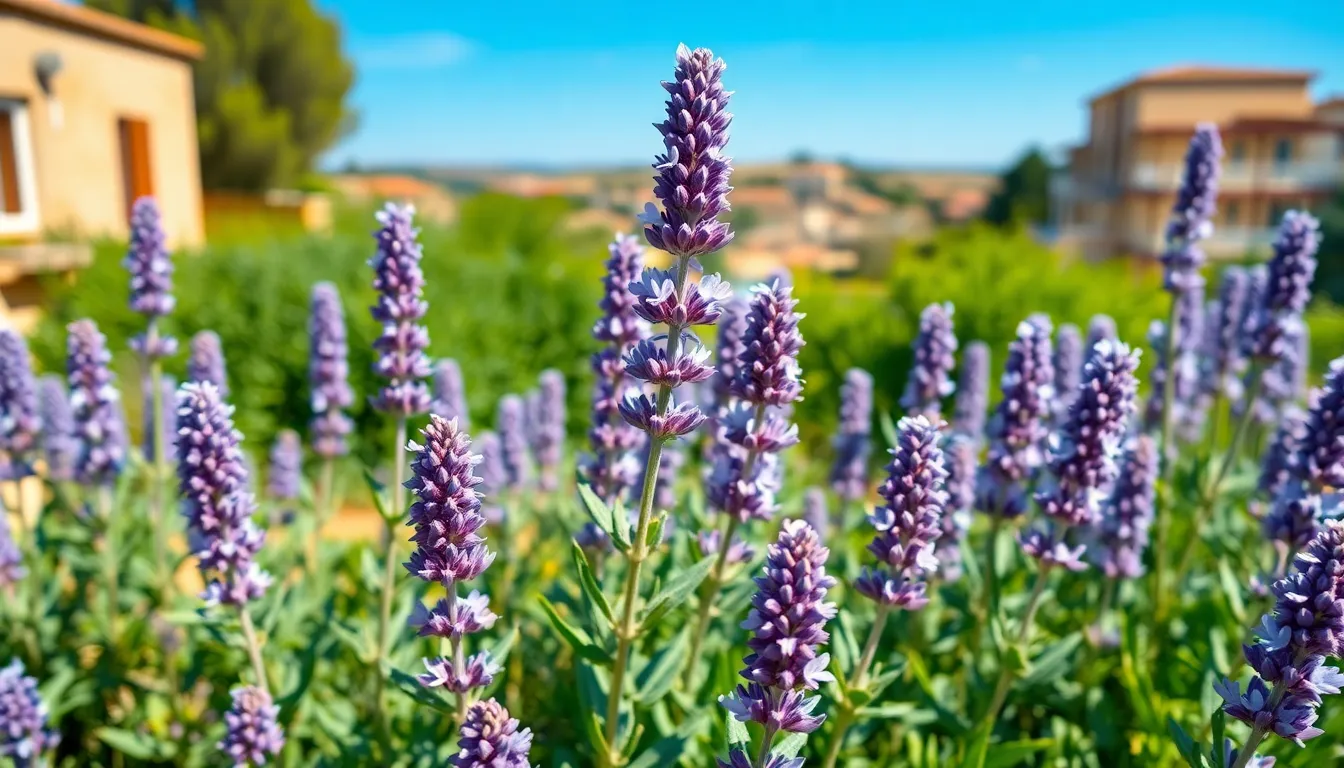
Portuguese lavender offers gardeners a distinctive Mediterranean species with remarkably intense aromatic properties. We find this variety particularly valuable for essential oil production and xeriscaping applications.
Aromatic Properties and Scent Profile
Portuguese lavender produces an exceptionally strong and pungent aroma that sets it apart from milder lavender varieties. Its scent carries pronounced camphor notes that create a more intense fragrance experience compared to the sweet, gentle aroma of English lavender. Essential oils extracted from the leaves contain these distinctive camphor compounds, making Portuguese lavender highly sought after for aromatherapy applications. We appreciate how this stronger scent profile makes it ideal for commercial essential oil production, where potent aromatic properties are valued for therapeutic formulations.
Native Habitat and Adaptability
Native regions for Portuguese lavender include the western Mediterranean basin, spanning central Portugal, Spain, southern France, and northern Italy’s Liguria region. This hardy shrub thrives from sea level up to 1,700 meters in altitude, demonstrating remarkable adaptability to varying elevations. Drought tolerance makes it perfectly suited for sunny, well drained environments typical of Mediterranean climates. Growth characteristics include reaching heights of 30 to 80 cm with evergreen, broad leathery leaves and pale lilac flower spikes. Blooming occurs from June through September, with timing dependent on local weather conditions and seasonal variations.
Culinary and Therapeutic Uses
Therapeutic applications dominate the uses for Portuguese lavender, particularly in aromatherapy where its camphor rich essential oil provides stress relief and respiratory benefits. Antiseptic properties make the oil valuable for various medicinal preparations and natural healing remedies. Culinary uses remain limited compared to English lavender due to the stronger, more pungent flavor profile that can overpower delicate dishes. We recommend Portuguese lavender primarily for essential oil production and therapeutic applications rather than cooking, where its intense aroma may not complement food preparations as effectively as milder lavender varieties.
Choosing the Right Lavender Type for Your Garden
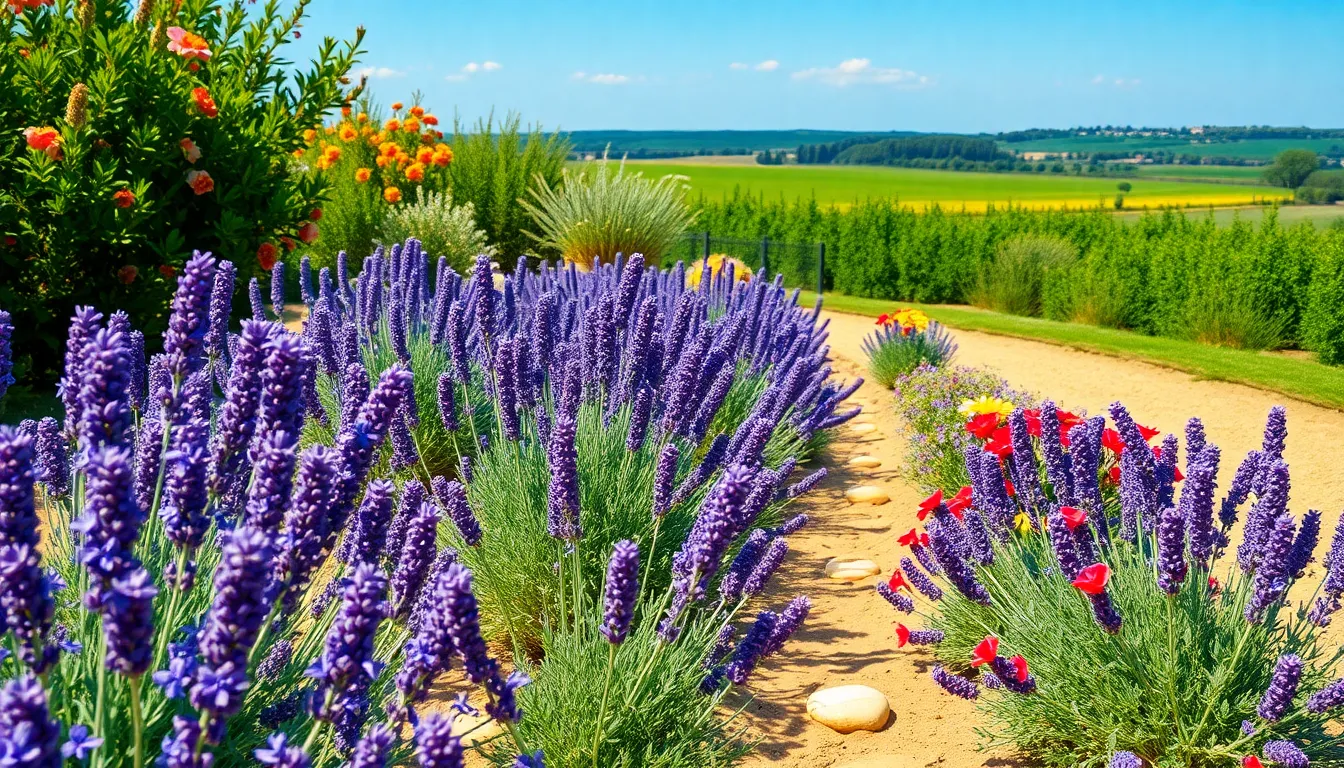
Selecting the perfect lavender variety requires careful consideration of your exact growing conditions and garden goals. We’ll guide you through the essential factors that determine which lavender types will thrive in your space.
Climate Considerations and Hardiness Zones
Understanding your USDA hardiness zone is crucial for lavender success since different species tolerate varying temperature ranges. Spanish Lavender varieties like ‘Strawberry Ruffles’ flourish in zones 8-9, while French Lavender such as ‘Goodwin Creek Grey’ demonstrates hardiness in zones 7-9.
English Lavender proves most cold-tolerant, surviving in zones 5-8 depending on the cultivar. Mediterranean climates provide ideal conditions for most lavender types, offering the warm, dry summers these plants crave.
Heat tolerance varies significantly among species, with Spanish and Portuguese lavenders handling extreme temperatures better than their English counterparts. We recommend choosing varieties that match your region’s temperature extremes to ensure long-term garden success.
Soil Requirements and Drainage Needs
Most lavender plants demand well-drained, neutral to alkaline soils with pH levels between 6.5-7.5 for optimal growth. Sandy soils work particularly well for Spanish Lavender types, providing the excellent drainage these Mediterranean natives require.
Clay soils present challenges for lavender cultivation since they retain moisture and can lead to root rot. We suggest amending heavy soils with sand, gravel, or perlite to improve drainage before planting.
Poor, rocky soils often produce the most fragrant lavender plants, as nutrient-rich conditions can encourage excessive foliage growth at the expense of essential oil production. Avoid fertilizing established lavender plants unless soil tests reveal severe deficiencies.
Space Planning and Mature Size Expectations
Planning adequate spacing prevents overcrowding and ensures proper air circulation around your lavender plants. Spanish Lavender ‘Strawberry Ruffles’ reaches maturity at 20-24 inches tall and 18-21 inches wide, requiring approximately 3 feet between plants.
French Lavender ‘Goodwin Creek Grey’ grows larger, achieving 18-24 inches in height and spreading 24-30 inches wide at maturity. These size considerations help determine plant placement and garden design.
Compact varieties work well for container gardening and small spaces, while larger lavandin hybrids need room to spread. We recommend measuring your available space and researching exact cultivar dimensions before purchasing plants to avoid future transplanting needs.
Conclusion
With seven distinct lavender varieties to choose from we’ve equipped you with the knowledge to select the perfect plants for your garden. Each type offers unique benefits whether you’re seeking culinary herbs medicinal properties or stunning ornamental displays.
Remember that success with lavender comes down to matching the right variety to your climate and soil conditions. From cold-hardy English lavender to heat-loving Portuguese varieties there’s a perfect match for every garden zone.
We encourage you to start with one or two varieties that suit your local conditions then expand your collection as you gain experience. Your garden will reward you with years of fragrant blooms and the satisfaction of growing these remarkable Mediterranean treasures.
Frequently Asked Questions
What are the main differences between English and French lavender?
English lavender (Lavandula angustifolia) is the most versatile variety, perfect for culinary use and essential oils, with classic purple spikes. It’s cold-hardy in zones 5-8. French lavender (Lavandula dentata) features distinctive toothed foliage and can bloom year-round in Mediterranean climates. It’s less cold-tolerant, thriving in zones 8-11, and grows as an evergreen subshrub reaching 2-5 feet tall.
Which lavender variety is best for beginners?
English lavender is ideal for novice gardeners due to its versatility and ease of care. Popular cultivars include ‘Hidcote,’ ‘Munstead,’ and ‘Royal Velvet.’ It requires minimal maintenance, needing only full sun, well-draining soil, annual pruning, and minimal watering. English lavender is also the most cold-tolerant variety and offers multiple uses including cooking, aromatherapy, and crafts.
What makes Spanish lavender unique compared to other varieties?
Spanish lavender (Lavandula stoechas) stands out with its ornamental barrel-shaped flower spikes topped with colorful bracts, earning nicknames like “butterfly lavender” and “rabbit’s ears.” It provides a long flowering season from late spring through summer with deep purple blooms. This compact variety grows 10-24 inches tall and requires careful post-bloom pruning to maintain shape and promote bushier growth.
What is Lavandin and how does it differ from other lavender types?
Lavandin (Lavandula x intermedia) is a hybrid combining English and Spike lavender traits. It produces larger shrubs with abundant flower spikes and blooms later (July-September). While its strong flavor limits culinary use, it’s primarily cultivated for commercial essential oil production. Popular varieties include ‘Phenomenal,’ ‘Grosso,’ and ‘Provence,’ offering unique characteristics for both ornamental and commercial applications.
Which lavender varieties are best for hot, dry climates?
Woolly lavender (Lavandula lanata) excels in hot, dry conditions with exceptional drought resistance and distinctive silver-gray foliage. Portuguese lavender (Lavandula latifolia) also thrives in Mediterranean climates. Both varieties are ideal for xeriscaping and water-wise gardening. French lavender also performs well in drought conditions, making these three excellent choices for challenging, arid environments.
Can lavender be grown indoors or in containers?
Yes, several lavender varieties work well for container gardening. Fernleaf lavender (Lavandula multifida) is particularly suitable for smaller spaces and indoor growing due to its compact size and fern-like appearance. It can provide nearly year-round color in mild climates and may be moved indoors during winter in cooler zones. Proper drainage and full sun exposure remain essential for container-grown lavender.
What are the ideal growing conditions for most lavender varieties?
Most lavender varieties require full sun exposure and well-draining, neutral to alkaline soil. They prefer minimal watering once established and benefit from annual pruning. For heavy clay soils, drainage improvement is crucial. Proper spacing prevents overcrowding, and understanding your USDA hardiness zone helps select appropriate varieties. Avoid overwatering, as lavender is naturally drought-tolerant and susceptible to root rot in soggy conditions.
Which lavender varieties are best for culinary use?
English lavender is the top choice for culinary applications due to its mild, sweet flavor and versatility. Popular culinary cultivars include ‘Munstead’ and ‘Hidcote.’ Avoid using Lavandin varieties for cooking as they have an overpowering flavor. Portuguese lavender is also not recommended for culinary use due to its intense camphor notes. Always use culinary-grade, pesticide-free lavender for food preparation.







